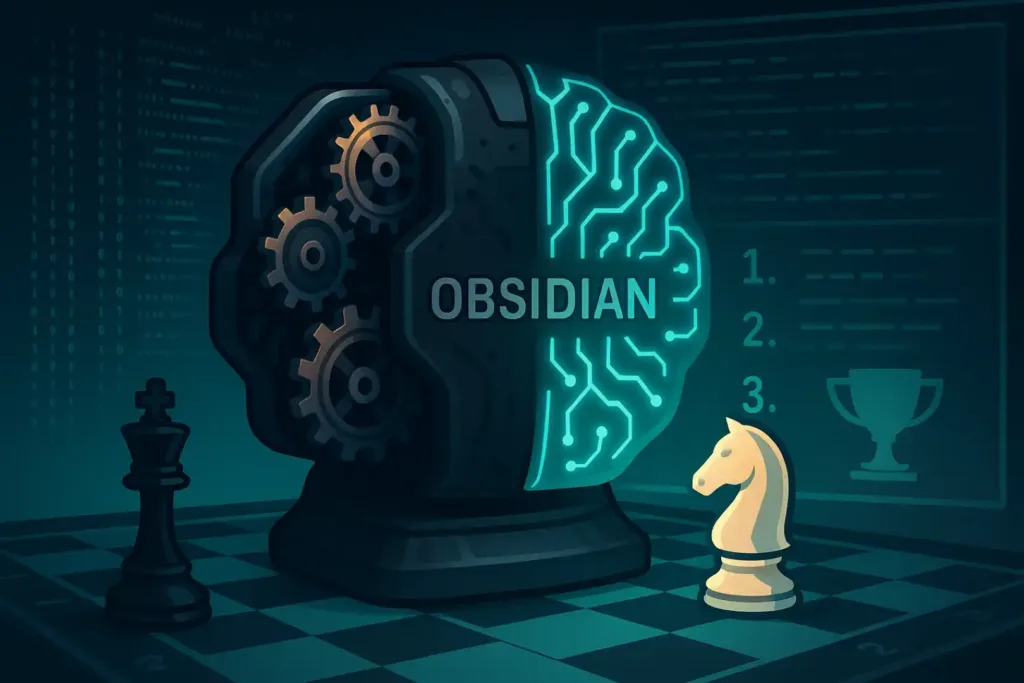Obsidian
Introduction
In the fast-paced world of computer chess, innovation and consistent improvement are the keys to staying competitive. Over the past few years, one engine has quietly climbed the ranks to challenge established titans: Obsidian. Originally conceived in April 2023 by developer gabe (GitHub user gab8192), Obsidian blends classical search techniques with modern neural-network evaluation to deliver an exceptional playing strength on par with — and in some cases surpassing — top engines like Stockfish and Torch.
This article explores the evolution and development of Obsidian, from the author’s earliest forays into chess programming through the creation of this UCI engine, to its most recent achievements in global rating lists. We will trace the milestones that have defined Obsidian’s journey, compare its performance against other leading engines since 2024, and present a current Elo-estimated top 10 list to contextualise its standing. Finally, we will consider the project’s future prospects, arguing why Obsidian is poised to remain a major contender in computer chess.
Key highlights of this article include:
- A detailed look at the author’s background in computer chess and the origins of Obsidian.
- An examination of Obsidian’s technical architecture, including its neural network integration.
- A review of the engine’s notable achievements and performance milestones since mid-2024.
- An up-to-date rating list table of the top 10 multi-CPU engines as of April 2025.
- A forward-looking analysis of Obsidian’s potential based on recent rankings and ongoing development.
By the end of this article, you will have a comprehensive understanding of how Obsidian has risen from a newcomer in 2023 to a leading force in computer chess, and why it represents one of the most exciting projects in the field today.
Early Years: The Author’s Beginnings in Computer Chess
Inspiration and Initial Forays
The story of Obsidian begins with gabe (GitHub user gab8192), whose passion for chess programming dates back several years. While gabe did not publicly document every step of his early career, his GitHub profile reveals a clear trajectory:
- Exploring existing engines: gabe experimented with and contributed to forks of established projects such as Patricia and berserk, gaining hands-on experience in engine architecture and search algorithms. His repositories “Patricia” and “berserk” reflect early attempts to understand and extend UCI chess engines (gab8192 (gabe) · GitHub).
- Learning from the community: Through engagement with open-source projects and collaboration on GitHub, gabe absorbed best practices in code optimisation, evaluation functions, and the use of endgame tablebases.
- Fostering a unique vision: Rather than merely forking others’ code indefinitely, gabe aspired to create an engine synthesising the speed of classical search with the depth of neural-network evaluation — a balance that would later define Obsidian.
Foundational Projects
Before Obsidian, gabe’s repository list included:
- FileDeleter: A utility reflecting early C++ proficiency.
- Patricia: A forked but aggressively tuned engine showcasing his interest in search enhancements.
- berserk: A C-based engine modified to test low-level optimisation techniques.
These projects provided a laboratory for experimenting with:
- Move-generation optimisations (bitboards, move ordering heuristics).
- Pruning techniques (alpha-beta enhancements, late move reductions).
- Evaluation improvements (tuning material and positional parameters).
By mid-2022, gabe had solidified his C++ skills and amassed enough engine-programming know-how to embark on a from-scratch project. He recognised that the next leap in engine strength would come from machine learning, and thus began planning for a hybrid design.

Creation and Development of Obsidian
Conception and Early Development
In April 2023, gabe launched the Obsidian repository on GitHub, marking the start of a new UCI engine written entirely in C++ (GitHub – gab8192/Obsidian: An UCI chess engine). From the outset, Obsidian was designed with performance and extensibility in mind:
- Architecture: A modular codebase separating search logic, evaluation, and I/O management.
- Build system: A flexible Makefile supporting multiple instruction-set targets (native, SSE2, SSSE3, AVX2, AVX512), with optional profile-guided optimisation for maximum speed.
- Neural network integration: Early recognition that a well-trained network could complement traditional evaluation, leading to collaboration with community members for network training.
Over its first six months, Obsidian’s commit history grew rapidly, with 570 commits by early 2025 — a testament to the engine’s active development and rapid iteration on features such as:
- Enhanced alpha-beta search with multi-cut pruning.
- Selective extensions for tactical sharpness.
- Improved quiescence search to manage tactical complexity.
Structure and Neural Network Integration
One of Obsidian’s defining characteristics is its neural evaluation. Unlike purely classical engines, Obsidian uses a network trained on Lc0 data, benefitting from lessons learned within the Leela Chess Zero community and leveraging high-quality EGTBs (endgame tablebases) for precise evaluation.
- Data sources: Training sets derived from extensive self-play and human-annotated games.
- Network design: A compact architecture optimised for speed on 128-thread machines, with contributions from Styxdoto and fireandice for CPU time and training resources (GitHub – gab8192/Obsidian: An UCI chess engine).
- Adaptive evaluation: Dynamic blending of classical material/positional scores with network output, allowing Obsidian to adjust to different time controls seamlessly.
By July 2024, Obsidian’s 10+1 time-control variant had reached third place globally, trailing only Stockfish and Torch, a remarkable feat for an engine just over a year old (GitHub – gab8192/Obsidian: An UCI chess engine).
Major Achievements of Obsidian Since 2024
Performance Milestones
Obsidian’s ascent through the rating lists over the course of 2024 and early 2025 is characterised by several key milestones:
- 18 July 2024: Achieved 3rd place at 10+1s, outperforming many long-established engines.
- 31 January 2025: Released Obsidian 15.0, which secured third place in the SPCC (another respected rating list) shortly after launch.
- 26 April 2025: In the CCRL Blitz Rating List (2’+1”), Obsidian 15.0 ranks 4th among all multi-CPU engines, with an Elo of 3786 (CCRL – Index).
These accomplishments underscore Obsidian’s rapid maturation:
- Consistent rating gains: From sub-3500 Elo in early 2024 to high 3700s by spring 2025.
- Competitive stability: Maintaining top-tier performance across multiple releases, despite aggressive optimisation by competitors.
- Community validation: Positive feedback from engine testers and regular participants in OpenBench and Lichess Arena matches.
Competitive Rankings
Aside from CCRL, Obsidian has featured prominently in:
- SPCC (Strategic, Positional, and Tactical computer chess list), where it held 3rd place in January 2025.
- BayesElo-based online tournaments against commercial engines, often finishing within a whisker of Komodo’s Dragon and Alexandrias.
Obsidian’s blend of classical search depth and neural evaluation has proven particularly effective in tactical positions, delivering precise calculations while avoiding catastrophic blunders.
Current Top Chess Engine Rankings
Elo Ratings of Leading Engines
Below is a table of the top 10 multi-CPU engines in the CCRL Blitz (2’+1”) Rating List as of 26 April 2025. These Elo figures are based on 1,578,954 games using BayesElo methodology (CCRL – Index).
| Rank | Engine | Version | CPU | Elo |
|---|---|---|---|---|
| 1 | Stockfish | 17.1 64-bit | 8-CPU | 3816 |
| 2 | Torch | v2 64-bit | 8-CPU | 3802 |
| 3 | PlentyChess | 5.0.0 64-bit | 8-CPU | 3789 |
| 4 | Obsidian | 15.0 64-bit | 8-CPU | 3786 |
| 5 | Alexandria | 8.0.0 64-bit | 8-CPU | 3785 |
| 6 | Dragon by Komodo | 3.2 64-bit | 8-CPU | 3785 |
| 7 | Berserk | 13 64-bit | 8-CPU | 3782 |
| 8 | Integral | 7.0.0 64-bit | 8-CPU | 3773 |
| 9 | Caissa | 1.21 64-bit | 8-CPU | 3766 |
| 10 | Lizard | 11.2 64-bit | 8-CPU | 3759 |
This table highlights Obsidian’s current 4th place among multi-CPU blitz engines — a remarkable position given its relative youth compared to decades-old projects.
Future Prospects for Obsidian
Strengths and Opportunities
Obsidian’s rapid climb in the ratings list suggests a bright future for the project. Key factors underpinning its prospects include:
- Active development: With a large pull-request backlog and an engaged contributor community, Obsidian benefits from continuous enhancements and feature additions.
- Neural-network roadmap: Ongoing efforts to train next-generation networks on larger datasets promise further gains in positional understanding.
- Hardware scalability: Optimisation for modern CPU instruction sets (AVX512, PGO) ensures Obsidian can harness the full power of cutting-edge processors.
- Open-source collaboration: The GPL-3.0 licence invites researchers and hobbyists alike to experiment, potentially uncovering novel pruning or evaluation strategies.
Challenges and Considerations
Despite its momentum, Obsidian faces stiff competition:
- Stockfish’s dominance: As the world’s top engine with broad developer support, Stockfish continually sets the bar for performance.
- Neural-only engines: Leela Chess Zero and novel MCTS-based engines challenge hybrid designs with deeper pattern recognition.
- Resource constraints: Training high-quality neural networks demands significant CPU/GPU time, necessitating sustained community investment.
However, Obsidian’s hybrid approach — integrating the best of classical search and machine learning — positions it uniquely to adapt to emerging paradigms in engine design. Its 3rd place standings in various time controls (10+1s, SPCC) reflect not only raw playing strength but also a well-balanced evaluation framework.
Bibliography
- Obsidian README: “A top tier UCI chess engine written in C++, that I started developing in April 2023… As of 18 July 2024, Obsidian is the 3rd strongest engine at 10+1s, after Stockfish and Torch. January 2025: It is 3rd in SPCC too.” (GitHub – gab8192/Obsidian: An UCI chess engine)
- CCRL Blitz Rating List: “Computed on April 26, 2025 with Bayeselo based on 1’578’954 games… Top multi-CPU engines list.” (CCRL – Index)
- GitHub Profile (gab8192): Repository list highlighting early engine forks (Patricia, berserk) and Obsidian as primary project. (gab8192 (gabe) · GitHub)

Jorge Ruiz Centelles
Filólogo y amante de la antropología social africana